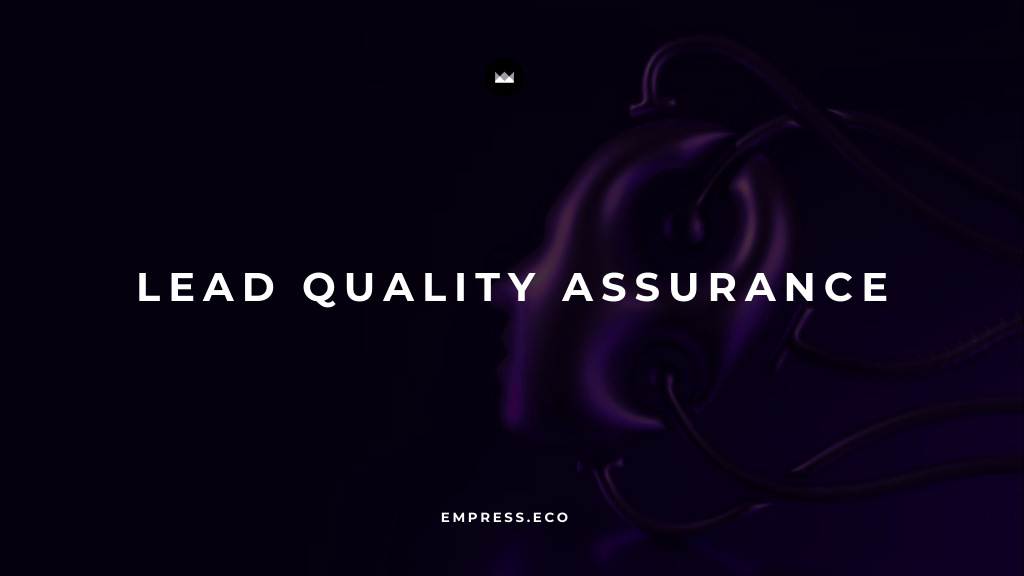
Monitor and Enhance Lead Quality with Assurance Strategies by IRIS
Table of Contents
In the world of sales and marketing, not all leads are created equal. While a large volume of leads might seem like a good thing, if those leads aren’t high-quality, they can waste valuable resources and fail to convert into customers. This is where lead quality assurance comes into play. By continuously monitoring and enhancing the quality of leads, businesses can ensure that their sales efforts are focused on the most promising prospects, leading to better conversion rates, optimized resource allocation, and sustainable growth.
Let’s delve into why lead quality assurance is so important and how you can implement it to make your sales and marketing strategies more effective.
Why Lead Quality Assurance Matters
Before we jump into the how, it’s crucial to understand why lead quality assurance should be a top priority for any business serious about growth. Think of your sales process as a funnel: at the top, you have all your potential leads, but as you move down the funnel, only the best leads—those most likely to convert—should make it to the bottom. Without a focus on lead quality, you risk spending time and resources on prospects who are unlikely to become customers, which can drag down your sales efficiency and overall business performance.
Lead quality assurance is about making sure that every step of your funnel is optimized to filter out the noise and focus on the leads that really matter. By continuously monitoring lead quality, you can make data-driven decisions that improve conversion rates and drive better business outcomes.
Key Benefits of Lead Quality Assurance
To fully grasp the value of lead quality assurance, let’s explore some of the key benefits it brings to your sales and marketing efforts.
1. Increased Conversion Rates
When your sales team is working with high-quality leads—those that have a genuine interest in your products or services and are ready to make a purchase—they’re much more likely to close deals. Focusing on quality over quantity means your sales reps spend their time with prospects who are more likely to convert, leading to higher conversion rates and, ultimately, more revenue.
Imagine a scenario where your team is receiving leads from various sources, but only a fraction of them are truly interested in what you offer. By implementing lead quality assurance processes, you can filter out the less promising leads and ensure that your sales team is only focusing on the best opportunities, making their efforts more effective and increasing your chances of closing deals.
2. Optimized Resource Allocation
One of the biggest challenges in sales and marketing is knowing where to allocate resources—whether it’s time, budget, or manpower. When lead quality is assured, you can prioritize your resources on the leads that are most likely to generate a return. This optimization reduces wasted efforts and enhances the overall effectiveness of your sales strategies.
For example, if your data shows that leads from a particular marketing channel consistently result in higher conversions, you can allocate more resources to that channel while reducing investment in less effective areas. This targeted approach ensures that your resources are being used where they will have the most impact.
3. Improved Customer Relationships
High-quality leads are not only more likely to convert; they’re also more likely to engage in meaningful interactions with your brand. Quality leads often result in better customer relationships because these prospects are genuinely interested in what you have to offer and are more likely to appreciate your outreach efforts.
When your sales team engages with leads who are a good fit for your products or services, the interactions are more likely to be positive and productive. This can lead to higher levels of customer satisfaction and loyalty, as customers feel that your brand truly understands and meets their needs.
4. Enhanced ROI
Marketing and sales efforts are significant investments, and every business wants to see a strong return on that investment (ROI). By improving lead quality, you increase the likelihood that your marketing spend will result in successful sales. High-quality leads are more likely to turn into customers, which means your marketing dollars are being spent effectively, maximizing the impact of your campaigns.
For instance, if your lead generation efforts focus on attracting quality prospects who match your ideal customer profile, your campaigns are more likely to result in conversions, driving up your ROI and contributing to the overall growth of your business.
Implementing Lead Quality Assurance: A Step-by-Step Guide
Now that we’ve discussed why lead quality assurance is important, let’s walk through how you can implement it in your business. The process involves setting clear criteria, leveraging data, and fostering collaboration between your sales and marketing teams.
Step 1: Define Lead Criteria
The first step in ensuring lead quality is to define what a quality lead looks like for your business. This involves establishing clear criteria that your sales and marketing teams can use to evaluate and prioritize leads.
Here’s how to define lead criteria:
- Identify Key Demographics: Consider the demographic factors that are most important for your business, such as age, location, industry, or company size. These factors can help you determine whether a lead is likely to be a good fit for your products or services.
- Assess Engagement Levels: Look at how engaged the lead is with your brand. Have they visited your website multiple times? Have they downloaded content or signed up for a webinar? High levels of engagement are often a good indicator of a quality lead.
- Evaluate Purchasing Intent: Consider the lead’s stage in the buying process. Are they just starting to explore their options, or are they ready to make a purchase? Leads with clear purchasing intent should be prioritized.
- Lead Scoring System: Develop a lead scoring system that assigns points based on the criteria you’ve defined. This system can help your team quickly identify and prioritize the most promising leads.
By defining clear lead criteria, you set the foundation for consistent and effective lead quality assurance. Everyone on your team will have a shared understanding of what constitutes a quality lead, making it easier to focus on the prospects that matter most.
Step 2: Use Data Analytics
Data is at the heart of lead quality assurance. By leveraging data analytics, you can continuously monitor and assess lead quality, ensuring that your criteria remain relevant and effective.
Here’s how to use data analytics for lead quality:
- Analyze Behavioral Patterns: Use data analytics to identify patterns in lead behavior that correlate with successful conversions. For example, you might find that leads who visit your pricing page are more likely to convert, or that those who engage with certain types of content are more interested in your offerings.
- Refine Lead Scoring Models: Continuously refine your lead scoring models based on data insights. If you discover that certain behaviors or characteristics are strong indicators of lead quality, adjust your scoring system to reflect these findings.
- Monitor Conversion Rates: Keep a close eye on your conversion rates and compare them against your lead quality metrics. If you notice that certain types of leads consistently convert at higher rates, use this information to further hone your lead criteria.
- Predictive Analytics: Consider using predictive analytics tools to forecast which leads are most likely to convert. These tools can help you prioritize leads even before they engage with your sales team, improving efficiency and effectiveness.
By using data analytics, you can make informed decisions about lead quality and continuously improve your lead generation efforts.
Step 3: Regularly Review and Update Criteria
Lead quality is not a set-it-and-forget-it process. The criteria that define a quality lead can change over time, influenced by market trends, customer feedback, and sales outcomes. To ensure that your lead quality assurance efforts remain effective, it’s important to regularly review and update your lead criteria.
Here’s how to keep your criteria up to date:
- Monitor Market Changes: Stay informed about changes in your industry or market that could impact what makes a lead valuable. For example, if there’s a new trend or emerging technology in your industry, adjust your criteria to prioritize leads who are interested in these areas.
- Gather Customer Feedback: Regularly gather feedback from your customers to understand what they value most in your products or services. Use this feedback to refine your lead criteria, ensuring that you’re attracting prospects who are a good fit for your offerings.
- Sales Team Insights: Your sales team is on the front lines, engaging with leads every day. Establish feedback loops between your sales and marketing teams to share insights about lead quality. If your sales team identifies patterns or characteristics that indicate a high-quality lead, incorporate this information into your lead criteria.
- Continuous Improvement: Treat lead quality assurance as an ongoing process of continuous improvement. Regularly review your lead scoring models, data analytics, and conversion rates to identify areas for enhancement.
By regularly reviewing and updating your lead criteria, you can ensure that your lead quality assurance efforts are always aligned with the current needs of your business.
Step 4: Implement Feedback Loops
Effective lead quality assurance requires collaboration between your sales and marketing teams. Feedback loops are a crucial part of this process, allowing both teams to share insights and refine their strategies based on real-world outcomes.
Here’s how to establish effective feedback loops:
- Regular Meetings: Schedule regular meetings between your sales and marketing teams to discuss lead quality and share insights. These meetings can help both teams stay aligned and ensure that everyone is working towards the same goals.
- Shared Metrics: Use shared metrics and KPIs to measure lead quality and track progress. By focusing on the same metrics, both teams can easily identify what’s working and where improvements are needed.
- Continuous Communication: Encourage ongoing communication between your sales and marketing teams. This could involve regular check-ins, shared reports, or collaborative tools that allow both teams to access and update lead data in real time.
- Feedback on Lead Scoring: Your sales team should provide feedback on the effectiveness of your lead scoring system. If they notice that certain high-scoring leads aren’t converting, or that low-scoring leads are unexpectedly valuable, use this feedback to refine your scoring models.
By establishing strong feedback loops, you create a collaborative environment where both sales and marketing teams can work together to improve lead quality and drive better results.
Challenges and Considerations in Lead Quality Assurance
While the benefits of lead quality assurance are clear, there are also challenges that you need to be aware of as you implement these processes.
1. Data Accuracy
The effectiveness of your lead quality assurance efforts hinges on the accuracy of your data. Inaccurate data can lead to misinformed decisions, flawed lead scoring, and ultimately, missed opportunities.
To ensure data accuracy:
- Regular Data Audits: Conduct regular audits of your data to check for errors, inconsistencies, and outdated information. This helps ensure that your lead scoring and quality assessments are based on reliable data.
- Data Cleansing Tools: Use data cleansing tools to automate the process of identifying and correcting errors in your data. This can save time and reduce the risk of human error.
- Standardized Data Entry: Implement standardized data entry practices across your organization to minimize the risk of errors and ensure consistency in your data.
By prioritizing data accuracy, you can make sure that your lead quality assessments are based on solid, reliable information.
2. Balancing Quantity and Quality
While it’s important to focus on lead quality, you also need to ensure that you’re generating enough leads to meet your sales goals. Striking the right balance between quantity and quality is key to a successful lead generation strategy.
Here’s how to balance quantity and quality:
- Set Clear Goals: Define clear goals for both lead quantity and quality. For example, you might set a target for the number of leads generated each month, as well as a target conversion rate.
- Diversify Lead Sources: Use a variety of lead generation sources to maintain a healthy pipeline of leads. This could include inbound marketing, outbound marketing, partnerships, and referrals.
- Monitor Lead Flow: Continuously monitor your lead flow to ensure that you’re generating enough leads to meet your goals without compromising on quality. If you notice a drop in lead volume, investigate the cause and adjust your strategy accordingly.
By finding the right balance between lead quantity and quality, you can ensure that your sales pipeline remains full while still focusing on the leads that are most likely to convert.
3. Integration with Existing Systems
Implementing lead quality assurance processes often requires integration with your existing CRM and marketing automation systems. Ensuring seamless integration is essential for efficient operations and accurate lead tracking.
Here’s how to ensure smooth integration:
- Choose Compatible Tools: When selecting tools for lead quality assurance, choose ones that are compatible with your existing systems. This ensures that data flows smoothly between platforms and that your teams can easily access and update lead information.
- Test Integration: Before fully implementing new tools or processes, conduct thorough testing to identify any potential issues with integration. This can help you address problems before they impact your lead quality efforts.
- Provide Training: Ensure that your teams are trained on how to use the integrated systems effectively. This includes understanding how to input data, access reports, and interpret lead quality metrics.
By ensuring seamless integration with your existing systems, you can streamline your lead quality assurance processes and improve overall efficiency.
Conclusion: The Importance of Continuous Lead Quality Assurance
Lead quality assurance is not a one-time task; it’s an ongoing process that requires continuous monitoring, refinement, and collaboration. By focusing on lead quality, businesses can improve conversion rates, optimize resource allocation, and build stronger customer relationships—all of which contribute to long-term growth and success.
In summary:
- Increased conversion rates result from focusing on high-quality leads that are more likely to become customers.
- Optimized resource allocation ensures that your sales and marketing efforts are directed toward the most promising prospects.
- Improved customer relationships are built through meaningful interactions with quality leads.
- Enhanced ROI is achieved by maximizing the impact of your marketing spend on leads that are likely to convert.
By implementing the strategies outlined in this guide—defining lead criteria, using data analytics, regularly reviewing and updating criteria, and establishing feedback loops—you can ensure that your business is always engaging with the most promising leads. As a result, you’ll be better positioned to achieve sustainable growth, maintain a competitive edge, and drive long-term success in your industry.
Empress Newsletter
Join the newsletter to receive the latest updates in your inbox.







